I recently ordered another geiger counter. I don't really need it, since I already have an old 1960s one that works quite well, but I wanted a more portable detector with a better speaker to easily hear radiation events. I found a Ukrainian/Russian Geiger counter on Ebay for around $35 (7 STEEM!) with integrated speaker and LCD, and as it has just arrived today, I'd like to go over what's inside and how it works!
Quick safety note, if for some reason you decide to take apart a Geiger counter, know that Geiger-Muller tubes work using high voltages up to several hundred volts. As such, taking one apart while it is on can lead to painful shocks. So, be careful.
Hopefully some of you will find this interesting!
Tearing down a Geiger Counter
Externals
This device is a "Sintex" Geiger radiation detector. It takes the form of a small black box with a yellow-green LCD displaying a three digit number, an on/off switch, and a red button. A small grill hides a speaker and on the back, under a screwed-down panel are slots for 3 AA batteries. Turn on the device, and it starts emitting a faint buzzing noise (the high voltage converter no doubt) followed by sharp audible clicks every 10 seconds or so, indicating background radiation detection.
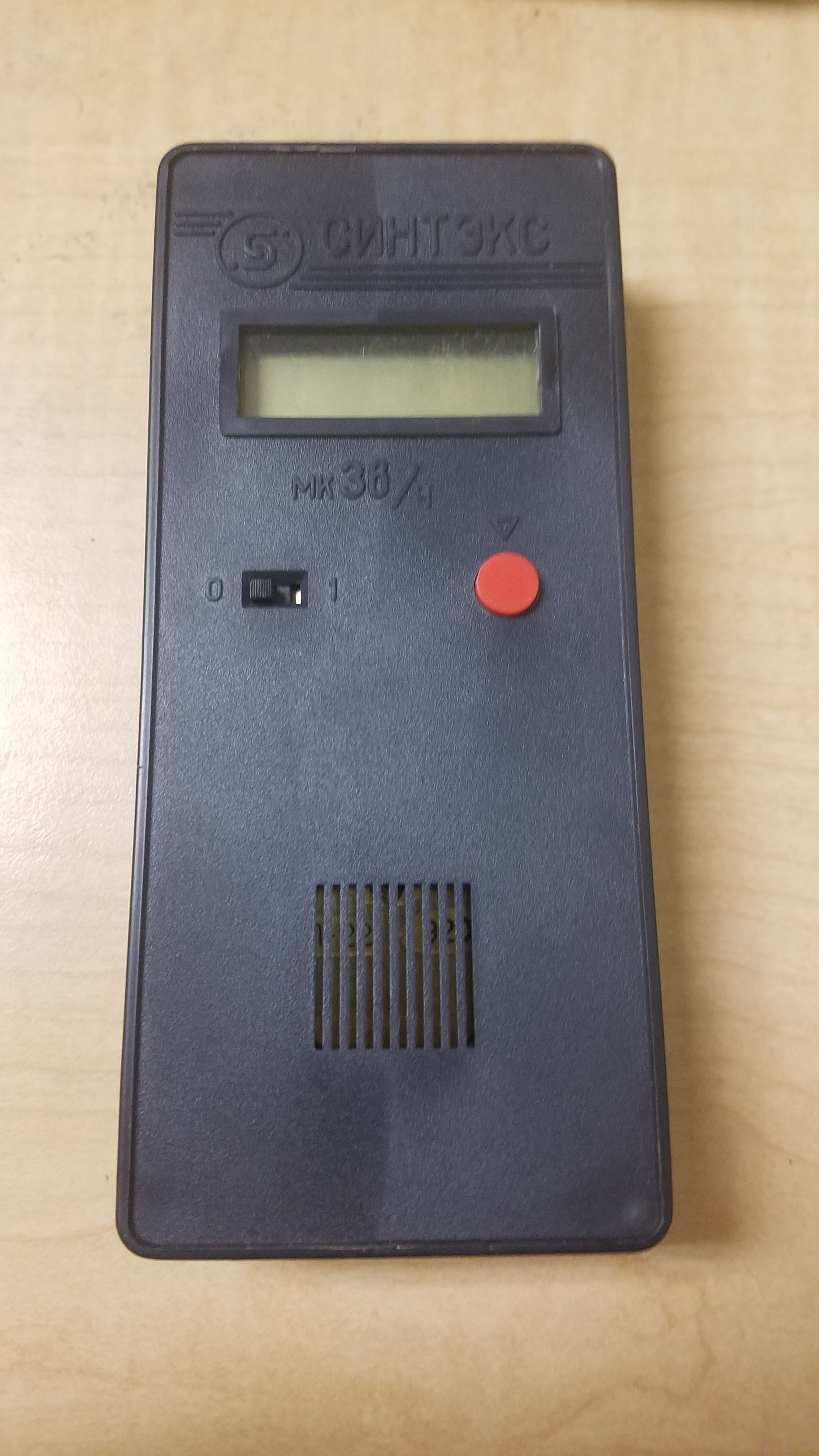
A display in Cyrillic on the back indicates that the LCD is displaying ionizing dose readings, and the red button allows you switch between modes. The dosages are displayed in micro-seiverts, which is a nice contrast to the antique Roentgens used on my other counter, a 55 year old CDV-700 from the US Civil Defense department.
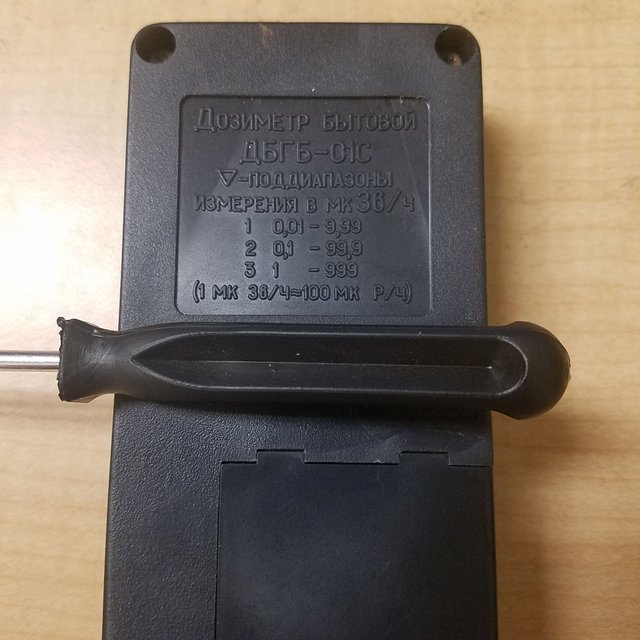
However, unlike many other radiation detectors, the Geiger tube/probe isn't visible. There is no port or anything to let radiation in. This means that the device is likely meant to be used to get ambient radiation levels rather than measure specific sources (although I will probably end up modifying it to have a small port for easily reading sources).
Opening up the device
The insides are quite a bit more interesting. The device is held together with four screws, one of which was hidden under a stamp of some tar-like substance that I had to scrape away. Inside, the detector itself is visible: A SBM-20 Geiger-Muller tube. This tube contains pressurized gas an two electrodes, and serves as the actual radiation detector.
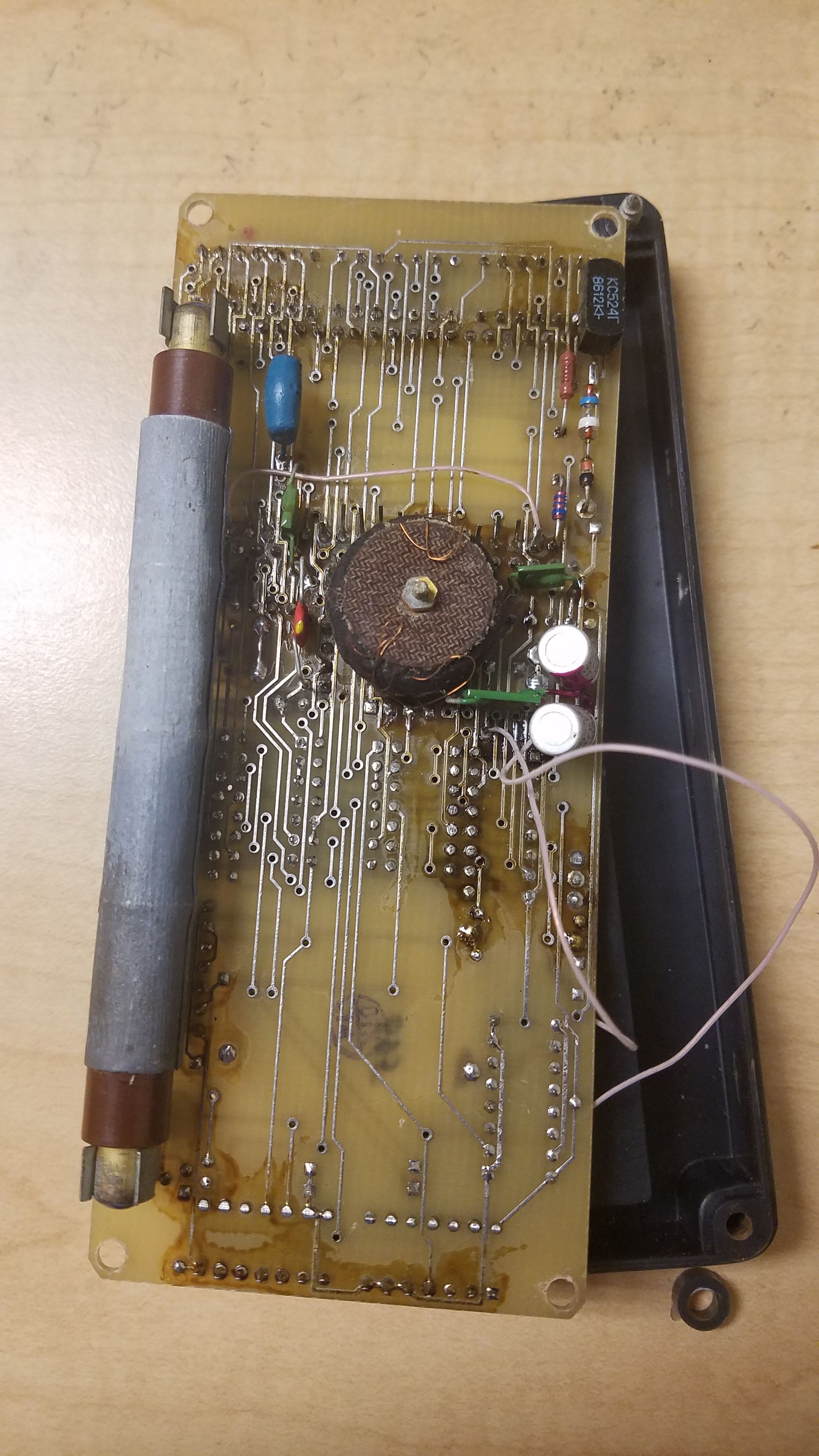
The big metal tube is the Geiger-Muller tube. This is what actually detects radiation.
Geiger-Muller tubes work by separating two conductive pieces of metal in a pressurized gas. When you apply a voltage to the electrodes, nothing happens, since the gas insulates the metal and no current can flow across the non-conductive gap. However, when an ionizing radiation particle enters the tube, it can strike and ionize gas molecules in the tube. These charged gas ions and electrons are now free charges, and can carry current across the tube. By applying a large voltage to the tube (several hundred volts typically), this effect can be amplified, causing any given radiation strike to produce hundreds of charged ions due to something called a Townsend Avalanche.
This has the effect of producing a pulse of current across the Geiger-Muller tube every time some particle of ionizing radiation strikes the inside the tube. Feed this pulsed signal into a detector circuit and you can count how many radiation events happened inside the tube, allowing you to accurately detect radiation.
Additional electronics lengthen the radiation-detection pulse and use it to send a longer, lower voltage pulse to the big output speaker. This produces the nice click you hear when radiation is detected, the classic Geiger counter sound.
One thing I love about older (25+) year old electronics are that they often are built in a way so as to make them easy to repair and service. Modern electronics drive me insane because they often make them intentionally difficult to take apart, modify, or repair, forcing you to waste more money buying a new device long before it should have been done for, resulting in endless waste of money and lots of new e-waste in the landfill. This radiation detector built the Geiger tube assembly in a way that allows you to easily snap the SBM-20 tube out of the detector at will, so that you can replace it with a new one if it breaks. SBM-20 tubes are very cheap on Ebay ($10 or so), so if for some reason you own a Sintex detector and happened to break the tube, you could just open it up and swap in a new one. Thumbs up for early-90s Russian and/or Ukrainian engineering.
Speaking of 90s, I originally thought that these cheap surplus Geiger counters were Soviet leftovers. After all, surplus Geiger counters and radiation detection equipment sold on Ebay out of Ukraine are some of the cheapest radiation detectors you can get. Turns out this device was made in 1993 (as printed on the back and in the provided manual), a few years after the USSR fell, so it's not quite as old as I thought. These being leftover USSR equipment was my best guess as to why so many were being stored in warehouses and sold for so cheap online, so I'm out of ideas now - oh well.
On the note of being easy to repair, this device came with its original 1993 operation manual (in Russian) and a full electrical schematic. This means that you could quite literally reproduce this device from scratch using only the schematic. I absolutely love this, because it means that if something were to break, I can refer to the schematic and replace essentially any of the parts. This is of course rarely done today, but apparently it used to be really common, because an old microwave I tore down awhile back and my 1960s geiger counter both have/had a full schematic taped to the inside. The schematic is on pretty beat-up paper, so I've scanned it into a PDF so that I don't lose it in case the paper decays away.
Here's a tiny portion of the schematic, showing the Geiger-Muller SBM-20 tube and associated connections. The entire circuit is detailed on this paper.
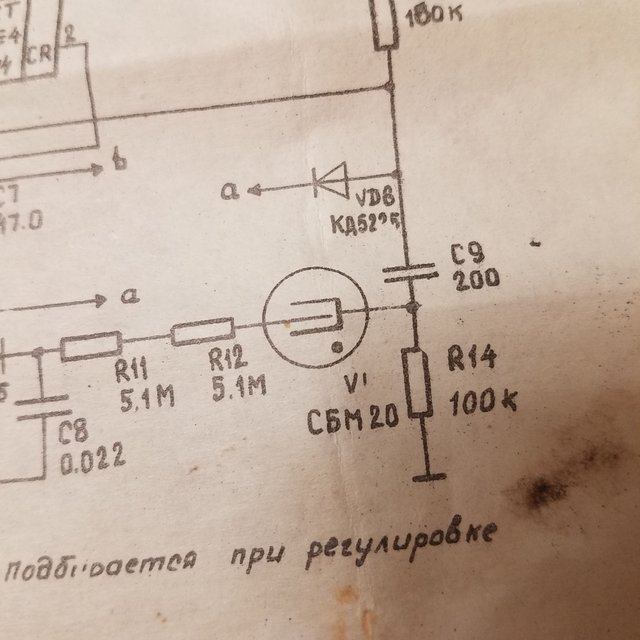
Also visible on the back of the circuit is the high-voltage portion of the circuit. According to the schematic, an AC signal is boosted to a high voltage using a transformer. A single-stage CW voltages doubler (consisting of two diodes and a capacitor) doubles the output voltage and provides high-voltage DC power to the SBM-20 detector tube, which it needs for operation.
Front side
The other side of the circuit has a lot more going on, but it's honestly less interesting. Tons of integrated circuits line the PCB, along with the LCD, dosage button, and speaker. Here's what the front looks like:
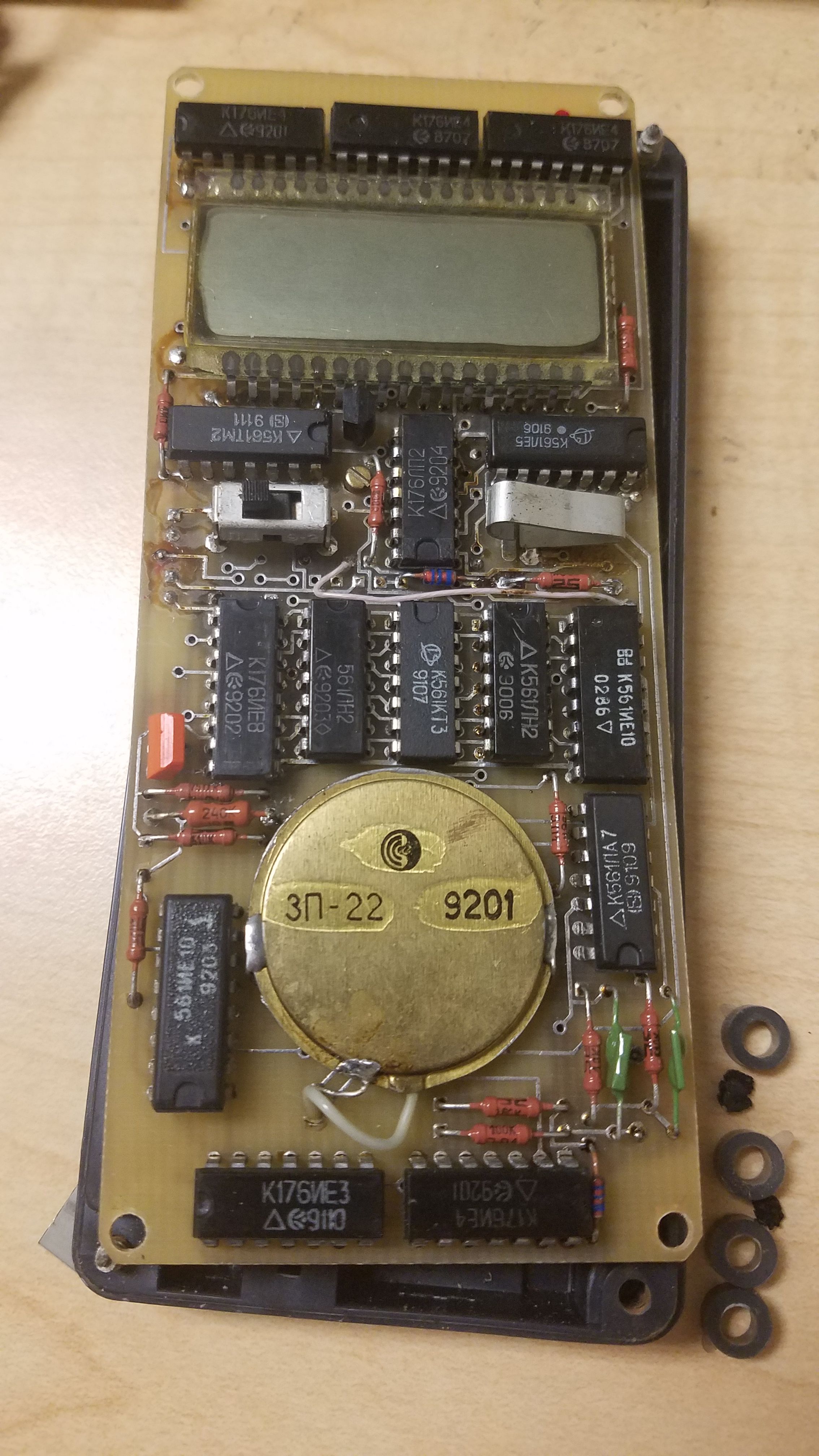
Once again, if something were to break, the hardest part would be finding the broken part. Everything looks easy to remove and replace, especially with the help of a fully-labeled schematic.
I assume the ICs are for amplification of the signal and driving the LCD. However, I don't have too much knowledge of what they do, so I'll leave it at that.
What can it detect?
Now that I've basically covered most of the innards, what can this device do? Of course, it detects ionizing radiation, but the kind of ionizing radiation it can detect is also important.
Like pretty much all detectors, this device can pick up cosmic muons and cosmic rays from the upper atmosphere. These register as background radiation clicks, arriving at a constant harmless rate.
The device is advertised as being built to detect gamma radiation. This makes sense, because the tube is hidden behind a plastic shield, and the tube being made out of metal doesn't lend itself well to picking up less-penetrating radiation. A nice surprise is that the device can pick up Am-241 59 keV gamma emissions with the case on, something I was worried it wouldn't be able to do as these gammas are quite easy to shield.
Alpha radiation, a common emission of very high energy (>5 MeV) Helium particles from very heavy elements, cannot be detected using this device. Alpha radiation is incredibly easy to completely stop (even 5.5 MeV Am-241 alpha rays will be stopped by paper, sticky tape, tissues, or a drop of water), so anything built to detect it needs to be able to let the alphas into the detector without leaking the internal gas. The sealed, metal SBM-20 will block any and all alpha rays before they can enter the gas-filled interior, so detecting alpha radiation with the Sintex is out of the question.

A good rough estimate of radiation absorption by type. Remember that this varies a ton based on particle energy, but for typical radioactive decay radiation the above image typically holds.
Credit
Beta radiation is a mixed bag. I was unable to pick up my other Geiger counter's small depleted uranium test source, which is as far as I know primarily a beta emitter. I would not be surprised if the Sintex device could pick up high energy (>500 keV) beta radiation, but for now it hasn't been able to pick up much beta.
As for X-rays, they are identical to gamma rays in all but origin. Since I know that 59 keV gamma rays make it through, 59 keV X-rays would also be detectable, as they are entirely identical to the aforementioned gamma rays. As for the X-rays I've made in my room with vacuum tubes, I'm doubtful that they could get through to the tube's interior at low 15-20 keV energies, but I might need to go try that when I get some time.
Conclusion
Plus a tiny rant
In case you can't tell, I'm pretty excited to find a cheap useful radiation detector. I'm even more excited that it came with a schematic and as such will be easy to repair or modify in the future. I'm not sure if I want to damage this device by doing so, but I might add a window in the back of the plastic over the tube to allow lower energy radiation into the detector.
To get on a soap box for a moment, I am quite saddened that the practice of making electronics serviceable has all but died in recent decades, with the exception of desktop computers and some others. Although surface-mount components, responsible for the revolution in inexpensive electronics and absolutely something that I don't want going away, are partly the reason for this due to them being difficult to replace, a lot of this comes from companies not wanting you to be able to repair your own things.
It's really a way to not let you actually own the device you are buying. By making your phone die in a few years when computers like desktops can last decades with upgrades and repairs (looking at you Apple, the company that makes it intentionally hard to do easy repairs like replace batteries so that they can slow down your device and trick you into buying a new one), companies are able to force people to rebuy products too soon while contributing to a ton of wasted electronics. I've also noticed that a lot of products are intentionally made difficult to take apart by things like hiding screws, not even having screws, making the internals unnecessarily complicated to make taking the product apart result in destroying it, or sealing electrical components in epoxy (something only acceptable to me when arcing high voltages are involved). A lot of these practices contribute to this issue, called planned obsolescence.
Sorry about the rant. Anyhow, it's refreshing how good this geiger counter actually is for 7 STEEM/0.003 BTC. If you'd like to get one yourself for radiation experiments or just checking your house for radioactivity, I can send you the Ebay seller, or you can build your own and I'd be happy to help you out.
Let me know if you have questions, comments, or if I got something wrong. I know this is a little bit of a different format post than I usually do, so if you have any suggestions for improvement please let me know!
Thanks for reading!
All images not credited are my own. You are welcome to use them with credit.
Additional Sources:
Townsend Discharge Wikipedia Entry
Really interesting, and great original work. Presumably you would need a different design of detector to pick up Alpha and Beta radiation?
Downvoting a post can decrease pending rewards and make it less visible. Common reasons:
Submit
For beta, you just need a tube that doesn't absorb all of the beta radiation in the walls of the tube before it can ionize the internal gas. Semiconductor detectors are somewhat good for beta since they don't have to be made with metal walls. This particular tube, the SBM-20, is entirely metal, and as such I expect it would have problems picking up all but the highest energy beta radiation.
As for alpha, you need a specially designed tube. Some I've seen use very thin mica windows to allow alphas into the tube for detection.
Downvoting a post can decrease pending rewards and make it less visible. Common reasons:
Submit
I guess the GM-tube is good enough to grab alpha, beta and gamma particles?
btw really nice post ! I like your radioactive posts (as well as the youtube channel bionerd23 XD) and no matter its in any formats :DD
Downvoting a post can decrease pending rewards and make it less visible. Common reasons:
Submit
Downvoting a post can decrease pending rewards and make it less visible. Common reasons:
Submit
WEI HONG CHUANG Electronics Co., Ltd. (SOPSMT), which specializes in SMT machines and spare parts. SOPSMT has more than 10 years of experience in the electronics processing equipment industry. Customers all over the world, and win the trust and praise of customers. Long-term customers include BOSCH and FLEX in Spain and India, , Panasonic in Mexico, Samsung and Cliptechin Brazil.
Downvoting a post can decrease pending rewards and make it less visible. Common reasons:
Submit